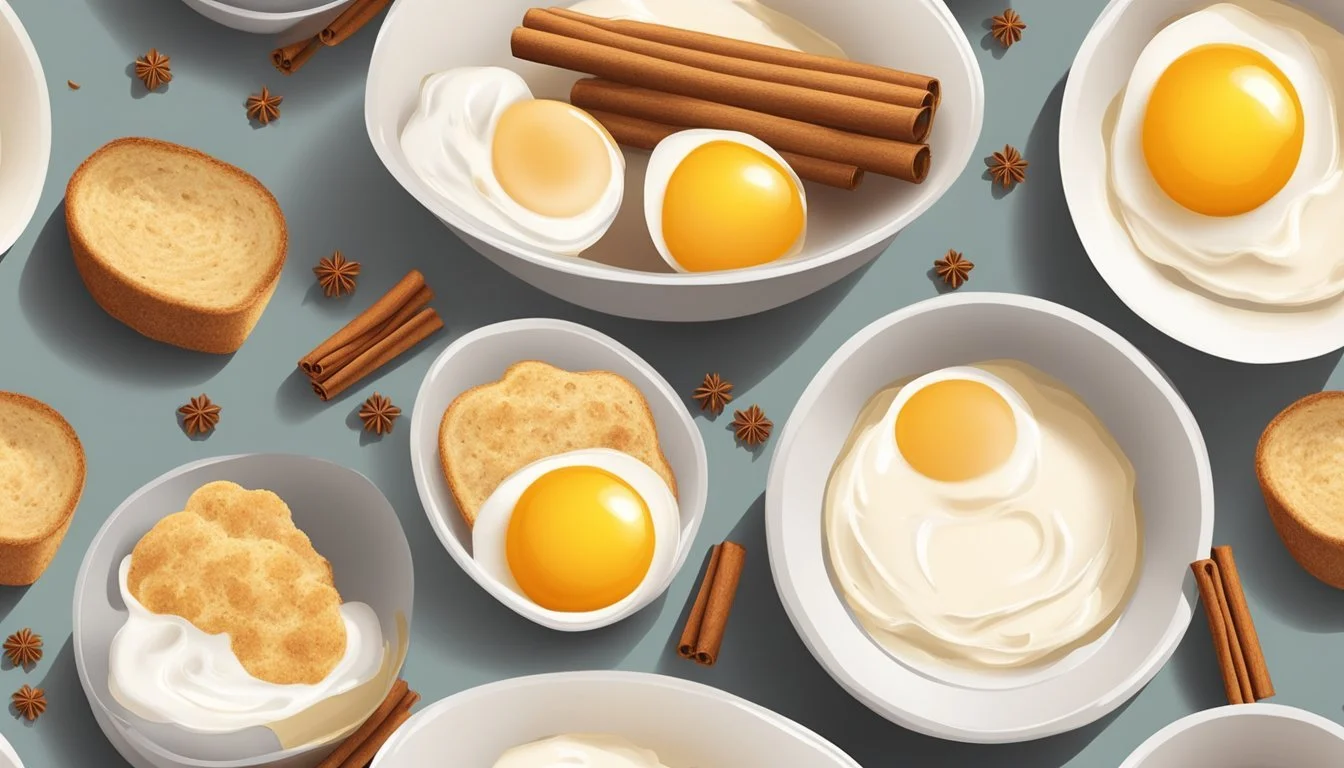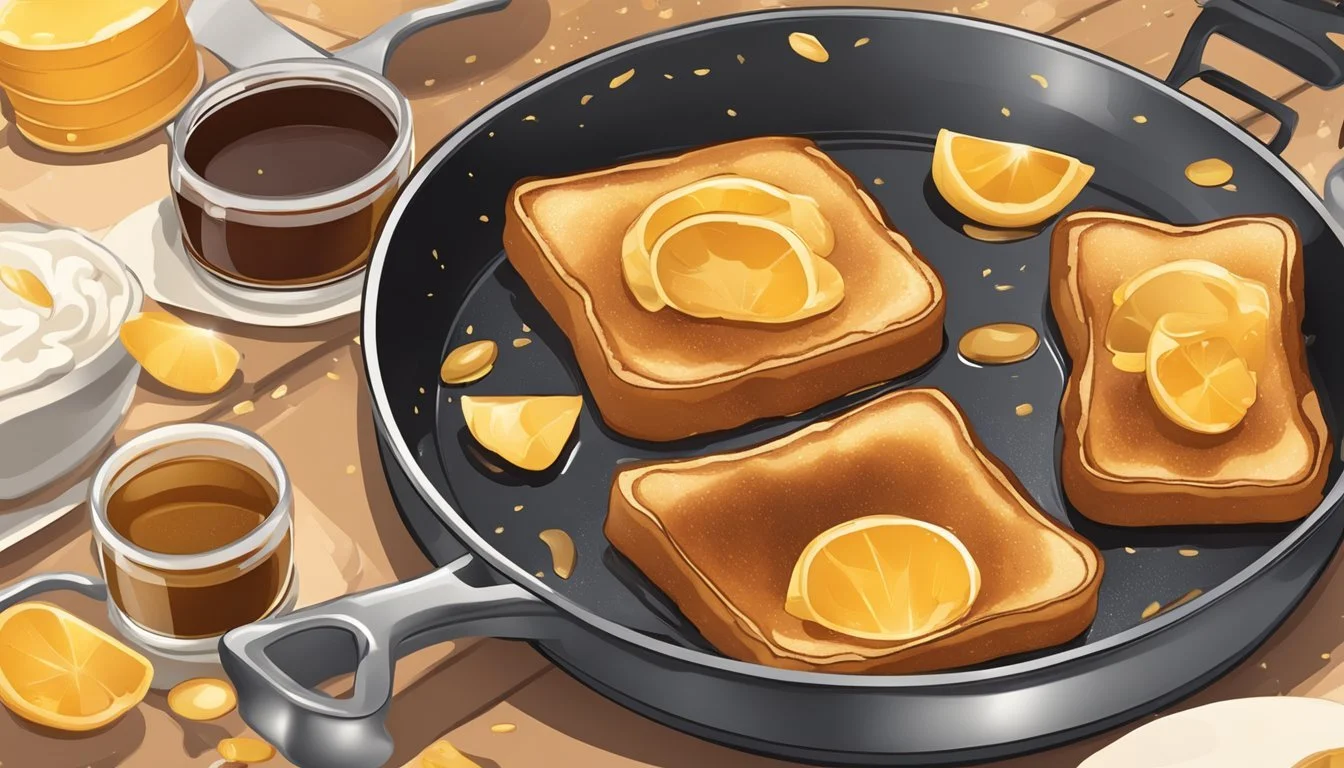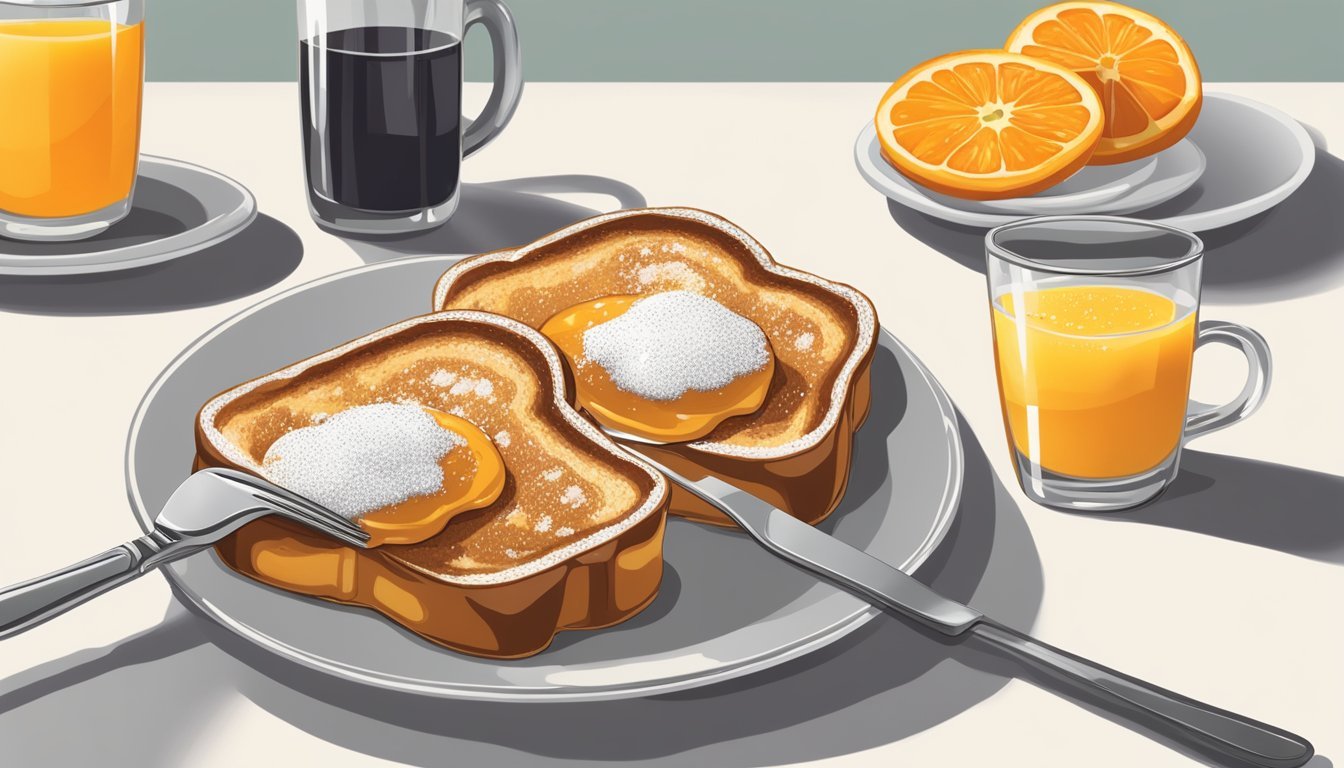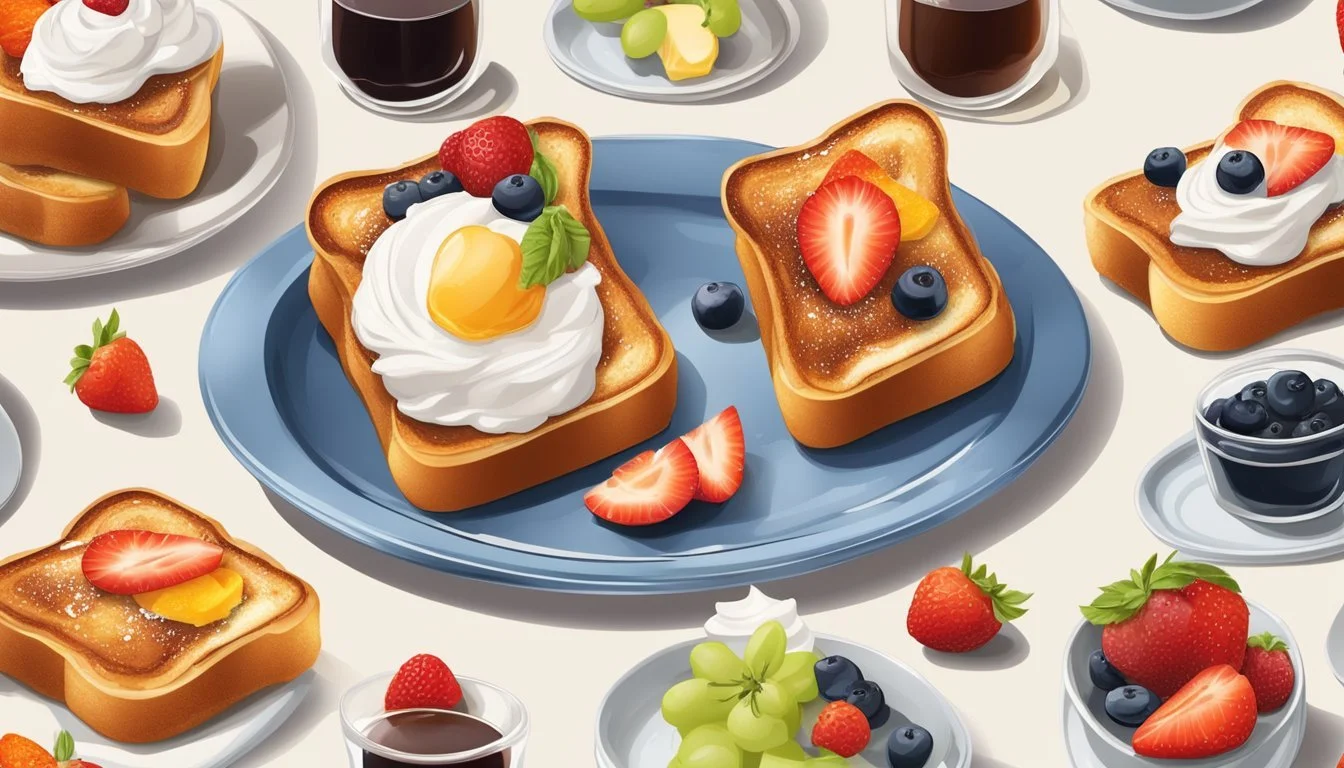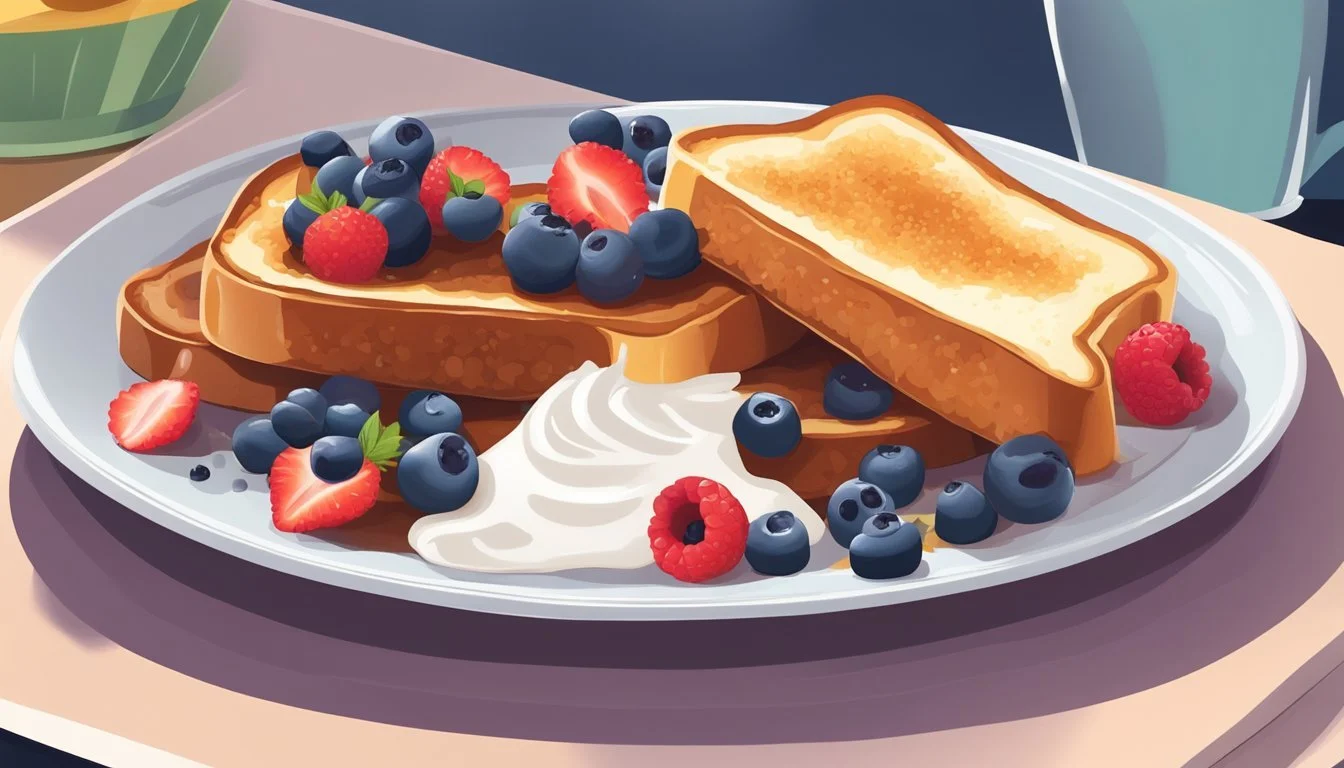How do you eat French toast?
Tips for Enjoying this Classic Breakfast Dish
French toast, a dish steeped in culinary tradition, offers a versatile and rich breakfast option enjoyed by people around the world. It is made by soaking slices of bread (how long does bread last?) in an egg and milk mixture, then frying them to golden perfection. Its appeal lies in its simplicity and the fact that it can be easily customized with a variety of toppings and flavorings to suit individual tastes.
When it comes to eating French toast, one can choose to either savor it in its classic form—lightly dusted with powdered sugar and a drizzle of maple syrup—or elevate it with an array of fruits, nuts, whipped cream, or even a sprinkle of spices like cinnamon or nutmeg for added aroma and flavor. It can be cut into neat triangles, served whole, or even stacked for a visually appealing presentation.
Despite the myriad of serving options, French toast consistently delivers a delightful interplay of textures and flavors, from the custard-like center to the crisp, buttery edges. Its universal appeal has made it a staple in both humble kitchens and high-end restaurants, revealing the endless possibilities that a few simple ingredients can create when combined.
Origins of French Toast
French toast, known for its rich history, is not originally from France as its name might suggest. The roots of this classic dish can be traced back to ancient Rome, where a recipe for it appears in the 4th-century collection, "Cooking and Dining in Imperial Rome" by Apicius. This early version, called aliter dulcia, which simply means "another sweet dish," involved soaking crustless white bread in a mixture and subsequently frying it.
Despite its Roman beginnings, the dish is closely associated with France, where it has been referred to as "le pain á la Romaine," hinting at its Roman origins, or alternately as "amerite." The evolution of the name "French toast" is not completely transparent, but records show its first appearance in the English language in 1871, in the Encyclopedia of American Food and Drink.
In France, the dish was thought to be created out of necessity to use up stale bread, reducing waste and providing an economical meal. Over time, it crossed boundaries and was embraced by different cultures, each adding their unique touch. Variants of the name, like "eggy bread," "gypsy toast," and "poor knights," suggest a widespread adaptation of the dish throughout Europe.
In contemporary times, French toast is a breakfast staple in many parts of the world, adorned with sweet toppings or served in savory variations. It is a testament to the exchange of culinary tradition across ages and regions, maintaining its essence as a comforting and versatile dish.
Selecting Ingredients
When preparing French toast, selecting high-quality ingredients ensures a flavorful outcome.
Bread: The foundation of any French toast is the bread. Choices like brioche, challah, and sourdough are popular for their texture and ability to soak up the custard without falling apart. Brioche offers a buttery richness, challah adds a slightly sweet flavor, and sourdough provides a tangy contrast.
Custard Mixture:
Eggs: They are essential for the custard base, providing structure and richness.
Milk: Whole milk is commonly used for its creamy texture, but alternatives like almond or oat milk can be utilized for dietary preferences.
Sugar: A touch of sugar sweetens the custard. The quantity can be adjusted to taste.
Cinnamon and Nutmeg: These spices impart warmth and complexity.
Vanilla: This adds a subtle fragrance and enhances the overall flavor profile.
Salt: Just a pinch is necessary to balance the sweetness.
Cooking Fat:
Butter gives French toast a rich flavor and crisp exterior. For a healthier version, vegetable oils can be substituted.
Toppings: While not a part of the cooking process, toppings like fresh fruits, powdered sugar, or syrup are often considered when selecting ingredients, as they complement the dish.
The table below summarizes the key ingredients:
Ingredient Notes Optional Alternatives Bread Brioche, challah, or sourdough preferred for texture Any bread that can absorb custard Eggs Essential for custard — Milk Whole milk for creaminess Non-dairy milk Sugar To taste Sweeteners like honey or maple syrup Cinnamon For spice and warmth — Nutmeg Adds depth — Vanilla Enhances flavor — Salt Balances sweetness — Butter For cooking Oil for a lighter option Fresh Fruits Ideal as a topping —
Choosing the right ingredients lays the groundwork for a sumptuous French toast that pleases the palate and presents beautifully on the plate.
Preparing the Batter
The batter is the heart of any French toast recipe. It acts as the custard base in which the bread is soaked, imparting rich flavor and a soft, melt-in-your-mouth interior.
To create the batter, chefs typically start with basic ingredients:
Eggs: The fundamental binding component for the batter. A common ratio is one egg per two slices of bread.
Milk: Using whole milk adds creaminess, but any kind can be used based on personal preference or dietary needs.
Cinnamon: A dash adds a warm, aromatic flavor.
Sugar: Sweetness can be adjusted to taste, but a little sugar enhances the custard.
Vanilla extract: A teaspoon of vanilla extract elevates the batter with a note of aromatic sweetness.
The process involves whisking together these ingredients until smooth, creating a homogenous mixture. Chefs advise that the key to a well-emulsified batter is patience and thoroughness.
Step-by-Step Guide to Batter Creation
Start with Eggs
Crack the desired number of eggs into a wide, shallow bowl.
Add Liquids and Flavorings
Pour in milk, vanilla extract, and sprinkle in sugar and cinnamon.
Whisk to Perfection
Combine the mixture with a whisk or fork until it becomes evenly mixed and slightly frothy at the surface.
Reminder: The consistency of the batter should be smooth, without any lumps, to ensure even coating of the bread. Chefs may taste the batter and adjust the sweetness or spice to ensure balance. After preparation, bread slices are dipped and fully immersed in the mixture, soaking up the delightful flavors before being cooked to golden perfection.
Soaking the Bread
The cornerstone of making French toast lies in how one soaks the bread. A proper soak transforms the bread into a delicious platform ready to carry the rich flavors of the custard batter—a mixture typically composed of milk, eggs, and flavorings. Key to this process is stale bread. Due to its drier texture, stale bread, like a brioche or a thick, rustic loaf, is more absorbent than fresh bread.
Soaking Time:
For optimal results, most recipes recommend a soaking time of about 15 to 20 minutes. This duration ensures that the bread is sufficiently saturated without falling apart.
Technique:
Place the slices of bread into the batter.
Apply firm, yet gentle, pressure to allow the batter to penetrate evenly.
If using regular, thinner slices, a shorter soak may suffice to prevent disintegration.
Slice Thickness:
Thicker slices of bread are able to handle longer soak times better than their thinner counterparts. When working with thick slices, one might consider soaking each side for approximately 10 minutes to ensure even absorption throughout.
Soaking Benefits:
A thoroughly soaked slice of bread will yield a custard-like interior once cooked—often described as the hallmark of perfect French toast. The milk in the batter contributes to tenderizing the bread, while the eggs coagulate during cooking to form a soft, rich center.
Remember to keep the bread intact and the batter well-infused for the ultimate French toast experience.
Cooking Techniques
French toast cooking techniques vary but typically involve using a skillet or oven to create that coveted custardy interior and golden-brown exterior. The choice of technique will also dictate the texture and flavor.
On the Stovetop
On the stovetop, one begins by melting butter in a nonstick skillet or frying pan over medium-low heat. The bread, having been soaked in a mixture of eggs and milk, is placed onto the skillet once the butter is foaming. It's essential not to overcrowd the pan. Cook each side until it reaches a golden brown color, ensuring a warm, custardy center.
Baking French Toast
For those preferring to bake, a baking sheet should be greased with butter and placed in a preheated oven. The egg-soaked bread is arranged on the baking sheet in a single layer to ensure even cooking. Baked French toast offers a more hands-off approach and can yield a slightly drier texture, but still with a golden crust if the oven temperature is correctly calibrated.
French Toast Casserole
French toast casserole is a convenient option for serving larger groups. It involves layering the custard-soaked bread in a buttered oven-safe dish, often with additional ingredients such as maple syrup, nuts, or fruit. The casserole is then baked until it's warm throughout and has a golden-brown topping. This method is excellent for achieving a consistently custardy texture throughout the dish.
Serving Suggestions
When indulging in French toast, an array of toppings and side dishes can enhance the experience. Here are some confident and clear suggestions to consider:
Toppings
Sweet:
Maple Syrup: A classic drizzle for its natural sweetness and complement to the toast's buttery flavor.
Powdered Sugar: A light dusting offers a subtle sweetness and decorative appeal.
Honey: For a floral note, a generous swirl of honey pairs beautifully.
Chocolate: Chocolate chips or a drizzle can add a rich and indulgent twist.
Fruit:
Fresh Fruit: Sliced strawberries, bananas (how long do bananas last?), or any fresh berries add a refreshing touch.
Berries Compote: Cooked berries can make a delightful syrupy accompaniment.
Enhancements
Whipped Cream: A dollop adds a creamy texture and aesthetic flair.
Nuts: Chopped almonds, walnuts, or pecans provide a crunchy contrast.
Savory Options
Eggs: Scrambled or poached eggs can balance the sweetness.
Bacon (how long does bacon last?): Crisp bacon strips make for a salty, savory side.
To serve French toast in a neutral and knowledgeable manner, arrange the dish with these suggested toppings or sides, catering to various palates. Remember, the key to an enjoyable French toast experience lies in the combination of textures and flavors that each accompaniment provides.
Accompaniments
When indulging in French toast, a variety of side dishes can elevate the meal to new heights. Opting for protein-rich options such as bacon or sausage links not only adds a savory contrast to the sweetness of the toast but also contributes to a more satisfying meal. Scrambled eggs are a classic choice, offering both a light texture and the nutritional benefits of eggs.
For those seeking a blend of flavors, smoked salmon can introduce a note of sophistication. Its salty, smoky taste harmoniously pairs with the custard-soaked bread, especially when complemented by cream cheese (how long does cream cheese last?) or a spritz of lemon juice.
On the lighter side, one might consider a fruit salad or berries for a refreshing element. These not only add a pop of color to the plate but also a burst of natural sweetness that can balance the richness of the French toast.
Here's a concise list of popular French toast accompaniments:
Category Accompaniment Options Protein Bacon, Sausage Links, Scrambled Eggs Seafood Smoked Salmon Fruits Fruit Salad, Berries Dairy Yogurt, Cream Cheese (how long does cream cheese last?)
For a crunchy texture contrast, sprinkling granola on top or on the side can add a delightful crunch that pairs well with creamy toppings like yogurt or peanut butter. These ingredients add a wholesome touch and an extra layer of flavor that complements the custardy profile of French toast.
One may also explore less conventional side dishes, serving French toast with a dollop of peanut butter for a protein boost and a hint of nutty flavor. In sum, the side dishes chosen can turn a simple plate of French toast into a well-rounded and enjoyable meal.
Topping Variations
When it comes to adorning French toast, wide-ranging options allow for endless creativity. The selection typically falls into two categories: sweet toppings that cater to those with a penchant for sugary delights and savory toppings that appeal to a more umami-forward palate.
Sweet Toppings
Sweet toppings on French toast offer a delightful contrast to the subtle, egg-infused custard of the bread. Here's a curated list showcasing a variety of sweet options:
Fresh Fruit: Sliced bananas, whole berries, and diced apples provide a refreshing burst of natural sweetness and a welcome textural contrast.
Nuts and Seeds: Sprinkle chopped pecans, slivered almonds, or pumpkin seeds for a crunchy element.
Syrups and Sauces: Classic maple syrup is a staple, while honey or chocolate sauce can add a rich, decadent layer of flavor.
Sugar Varieties: A dusting of powdered sugar or a sprinkle of granola mixed with brown sugar offers both sweetness and crunch.
Creamy Additions: Dollops of whipped cream or a smear of peanut butter lend creaminess and depth.
Fruit Compotes and Jams: Berry compotes or fruit jams provide a concentrated fruit flavor that pairs beautifully with plain or vanilla French toast.
Decadent Treats: For an indulgent twist, chocolate chips, caramelized bananas, or even a scoop of ice cream can elevate the French toast experience.
Savory Toppings
While French toast is often associated with sweet toppings, savory alternatives can transform it into a hearty meal:
Proteins: Crispy bacon, sausage links, or scrambled eggs add a savory punch and make for a more substantial dish.
Cheese: Melted mozzarella or a sprinkle of tangy feta cheese can offer a deliciously salty contrast.
Vegetables and Herbs: Sautéed mushrooms, roasted tomatoes, or fresh herbs like basil infuse earthy and aromatic flavors.
Rich Sauces: A drizzle of hollandaise sauce or a scoop of fresh salsa can introduce a complex blend of spices and tang.
Seafood: Topped with smoked salmon and perhaps a sprinkle of dill, French toast can become an elegant brunch item.
Seasonings: A touch of nutmeg or a pinch of freshly ground black pepper can subtly enhance the savory aspects of the toppings.
By mixing and matching these toppings, one can custom tailor their French toast experience to match their craving, whether it be sweet, savory, or a delectable fusion of both.
Adapting for Special Diets
When preparing French toast for special diets, it's essential to consider alternative ingredients that align with dietary restrictions without compromising taste and texture. French toast can be adapted for various diets such as gluten-free, dairy-free, vegan, low-carb, sugar-free, and high-protein.
Gluten-Free: Opt for gluten-free bread options available in most health food sections. They often use rice, almond, or coconut flour instead of wheat.
Dairy-Free: Substitute cow's milk with plant-based alternatives like almond, soy, or coconut milk. They provide a similar consistency and a hint of their respective flavors.
Vegan: To cater to a vegan diet, replace eggs with banana, applesauce, or a commercial egg substitute. Plant-based milks also ensure the recipe remains dairy-free.
Low-Carb: Create a low-carb version by using low-carb bread, such as those made with almond flour, and serve with fresh fruit instead of syrup.
Sugar-Free: Skip adding sugar or syrup. Sweeten the toast naturally with mashed bananas or puréed dates in the batter, and top with fresh berries.
Protein-Enhanced: Elevate the protein content by adding protein powder to the egg mixture or spread a layer of nut butter on the cooked French toast.
Diet Type Bread Substitute Milk Substitute Egg Alternative Gluten-Free Gluten-free bread -- -- Dairy-Free -- Plant-based milk -- Vegan Gluten-free (if necessary) Plant-based milk Banana/Applesauce Low-Carb Low-carb bread -- -- Sugar-Free -- -- Fruit purees/banana Protein -- -- Protein powder/nut butter
By incorporating these substitutions, individuals can still enjoy a delicious serving of French toast that adheres to their dietary needs.
Nutritional Information
French toast provides a blend of carbohydrates, proteins, and fats, making it a hearty breakfast option. Portion size and ingredient choices significantly affect its nutritional content.
Understanding Macronutrients
French toast typically consists of bread soaked in a mixture of eggs and milk before being pan-fried. One slice of French toast made with low-fat (2%) milk contains approximately:
Calories: 149 kcal
Protein: 7 g
Carbs: 18 g
Fat: 7 g
The protein comes from the eggs and milk, which contribute to muscle repair and growth. Carbs present in the bread provide the body with an energy source, while the fats, primarily from the eggs and milk, are essential for overall health.
Calories and Portion Control
The calorie content in French toast can range from about 160 calories for a regular slice to between 300 and 500 calories for two slices, depending on the preparation method and toppings. A mindful approach to portion sizes is crucial to maintain a balanced diet.
Portion Size Calories 1 regular slice 160 kcal 2 slices 300-500 kcal
One can also add calorie-dense toppings such as nuts, syrup, and whipped cream, which will increase the overall caloric intake.
Healthy Alternatives
One can opt for healthier preparations and toppings to enhance the nutritional value of French toast:
Use whole milk or low-fat milk instead of cream for soaking the bread.
Include toppings such as fresh berries, nuts, and honey or unsweetened applesauce for natural sweetness without the excessive sugar.
By using whole grains for the bread and adding fruit toppings, one can increase the fiber content and make the meal more nutritious while still enjoying the traditional flavors of French toast.
Storage and Reheating Tips
French toast can be a delicious treat, but it's important to store and reheat it correctly to maintain its taste and texture. Following proper storage methods extends its shelf life, and using the right reheating techniques ensures that it remains enjoyable to eat.
Storing Leftovers
When one has leftovers, they should store French toast in the refrigerator or freezer. In the refrigerator, French toast should be sealed in an airtight container or tightly wrapped in plastic wrap or foil to prevent drying out, allowing it to last for up to two days. For long-term storage, French toast can be frozen. One should place slices on a baking sheet to freeze individually and then wrap them in plastic or place them in freezer bags, which can keep for up to two months.
Best Reheating Practices
To retain the ideal texture—crispy on the outside and soft on the inside—the oven and stovetop are the best methods for reheating.
Oven Method: Preheat the oven to 400°F and place the French toast on a greased baking sheet. Heat for 6 to 8 minutes, flipping once halfway through. This method is effective for both refrigerated and frozen French toast, though frozen slices may require an additional few minutes.
Stovetop Method: Preheat a skillet over medium heat and apply a light coating of butter or non-stick spray. Warm each piece for 1-2 minutes per side, turning up the heat to crisp the exterior if desired.
Making Ahead for Meal Prep
For those who enjoy making French toast in advance, it can be a convenient make-ahead meal prepped for busy mornings. After cooking, let the French toast cool completely before freezing as mentioned in the "Storing Leftovers" section. To reheat, one can simply follow the reheating practices shared above, with the oven being a preferred method for larger batches or the stovetop for individual servings. This advance preparation can save time and provide a warm, flavorful breakfast on demand.
Unique Variations and Twists
French toast offers a versatile canvas for culinary creativity. Stuffed French Toast elevates the traditional breakfast by incorporating delightful fillings such as cream cheese, fruit preserves, or even chocolate spread. It transforms the meal into a sumptuous treat, taking taste buds on an indulgent journey.
French Toast Casseroles invite an easy, prepare-ahead approach for breakfast enthusiasts. They often include layers of bread soaked in custard, with additives such as blueberries in a Blueberry French Toast Casserole, or spices like cinnamon, making it a flavorful affair that's simplistically elegant.
Savory French Toast, a departure from the norm, entices those with a less sweet tooth. Adding herbs, cheese, and a pinch of salt can result in a rich, satisfying dish.
On the other hand, Vanilla and Cinnamon infusions are a staple for those who cherish classic sweet profiles. These ingredients infuse the bread with aromatic flavors that are both comforting and sophisticated.
Here's a brief insight into how the addition of these elements can transform French toast:
Ingredient Effect Vanilla Adds a sweet, floral note and depth of flavor Cinnamon Offers a warm spice that complements the sweetness Blueberries Contribute a juicy, tangy burst in every bite Cream Cheese Provides a creamy texture that contrasts with the soft bread
Such variations are not only mouthwatering but also serve as evidence of French toast's adaptability to one's palate and preferences. Whether one prefers their morning feast to be sweetly spiced or pleasantly piquant, French toast can be tailored to meet their desires.
Common Mistakes to Avoid
When crafting the perfect French toast, certain pitfalls can mean the difference between a delightful breakfast and a subpar dish. Attention to detail in bread choice, soaking time, and cooking heat is paramount.
Bread Selection Errors
Choosing the right type of bread is crucial for French toast. White sandwich bread often lacks the necessary structure, leading to soggy results. Brioche and challah, known for their sturdy yet light texture, are ideal. Stale bread is a smart choice as it absorbs the custard without falling apart.
Optimal Choices:
Brioche: Rich and buttery; holds up well during soaking.
Challah: Slightly sweet, egg-rich bread that maintains its integrity.
Stale Bread: Better soak distribution, avoiding sogginess.
Poor Choices:
Fresh White Sandwich Bread: Too soft; becomes overly soggy.
Over or Under Soaking
Achieving the right soak time ensures that the bread is sufficiently saturated but not overly soggy. Bread should be dipped in the custard, allowing it to penetrate just enough to result in a creamy custard texture once cooked. Under-soaking leads to dry, custard-less centers, while over-soaking can make your toast heavy and soggy.
Tips for Perfect Soaking:
Dip each side until just saturated.
Ensure no part of the bread remains dry or is dripping wet.
Incorrect Cooking Temperature
The cooking temperature must be controlled to avoid burnt exteriors or undercooked, soggy interiors. A nonstick skillet or frying pan over medium heat works best to cook French toast evenly, creating a golden-brown crust outside while keeping the inside custardy and soft.
Temperature Guidelines:
Medium Heat: Ensures thorough cooking without burning.
Preheated Pan: Start with a warm skillet to promote even cooking.




